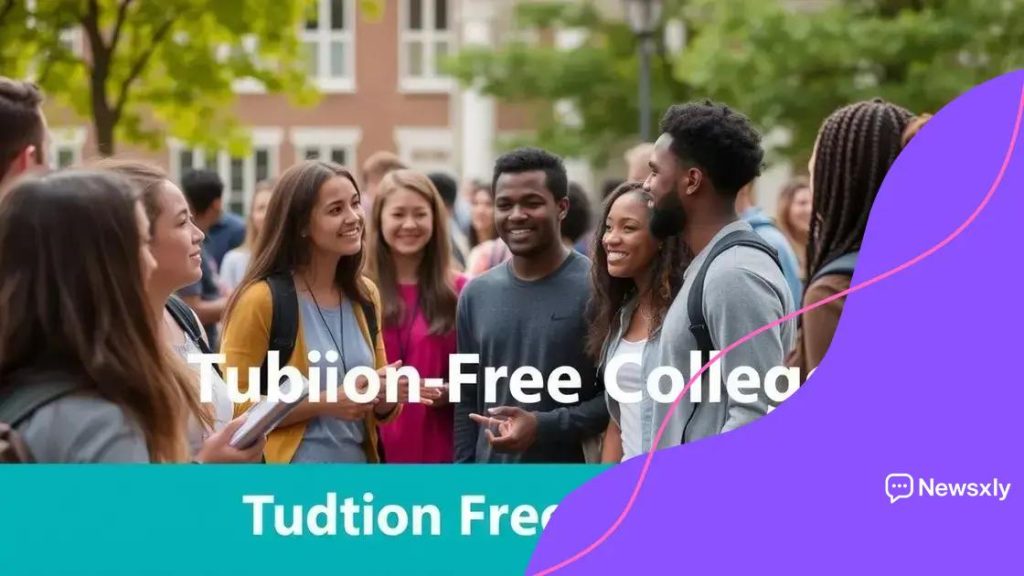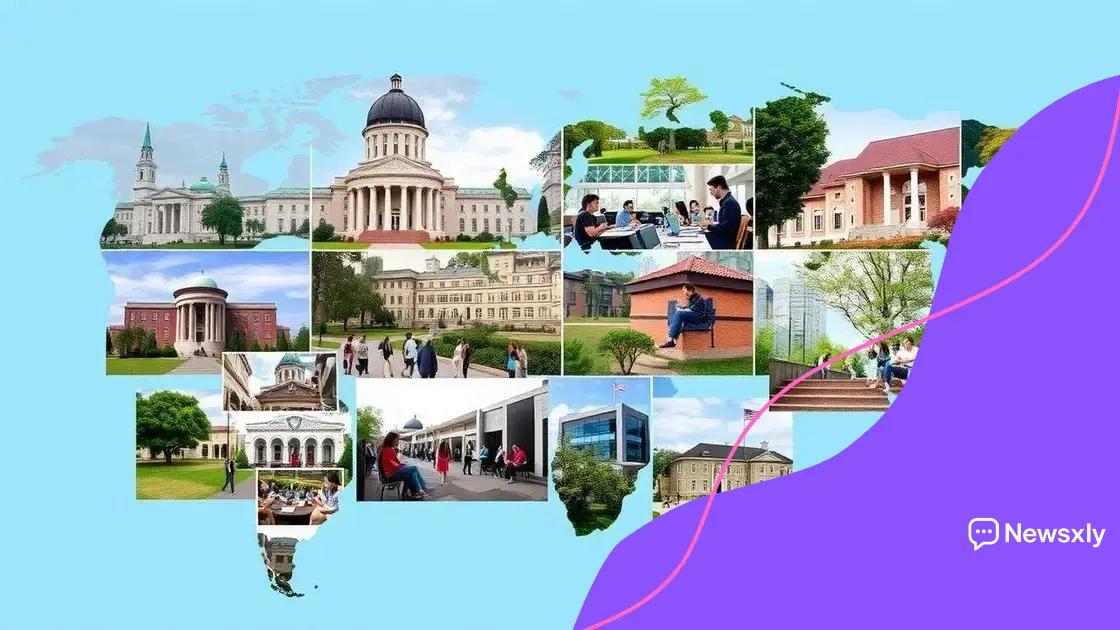The debate surrounding tuition-free college opportunities

The debate surrounding tuition-free college focuses on improving education access through various funding models, while facing challenges such as securing funding and overcoming political resistance.
The debate surrounding tuition-free college is heating up as many wonder about its feasibility and implications. Have you considered how it might affect student access and the job market?
Understanding the concept of tuition-free college
Understanding tuition-free college involves grasping its definition and significance in today’s educational landscape. This concept refers to colleges and universities that do not charge students for their education, allowing them to attend without the burden of tuition fees.
Such opportunities can lead to increased enrollment and greater accessibility for students from diverse backgrounds.
Key Benefits of Tuition-Free College
Tuition-free college has several advantages that make it an appealing option for many students:
- Increased access to higher education for low-income families.
- Reduction in student debt, promoting financial freedom.
- Encouragement for students to pursue higher education regardless of financial circumstances.
Moreover, by eliminating tuition costs, universities can attract talented individuals who might otherwise forgo a degree due to financial constraints. This can foster a more educated workforce, ultimately benefiting society as a whole. Additionally, tuition-free programs often encourage a more diverse student body, enriching the educational experience for everyone involved.
Implementation of Tuition-Free College Programs
The implementation of tuition-free college programs can take various forms. For instance, some states have developed community college programs that offer free tuition to residents. Others have proposed comprehensive plans that cover in-state tuition for public universities.
These programs often require certain commitments, such as maintaining a specific GPA or working a set number of hours during the school year. While these programs have shown promise, they also face challenges regarding funding and sustainability, which can impact their long-term viability.
In conclusion, understanding the concept of tuition-free college is essential for discussing its broader implications. By exploring its potential benefits and challenges, we gain insight into the future of education and access for all students.
The economic impact of tuition-free education
The economic impact of tuition-free education is a vital topic as more schools consider this model. Tuition-free education can lead to significant changes in society by reducing the financial burden on students.
This can mean a brighter future for many, leading to a more educated workforce.
Benefits to the Economy
When education is more accessible, the economy tends to improve in several ways:
- Increased number of graduates can fill high-skill jobs.
- Lower student debt allows young adults to spend more on housing, vehicles, and other goods.
- Having a better-educated workforce boosts productivity.
These benefits collectively stimulate economic growth. As more individuals attain higher education, the potential for income increases, driving demand in various sectors.
Challenges and Solutions
While tuition-free education offers numerous benefits, it also presents challenges. Funding such programs can be difficult, and there are concerns about sustainability.
Some propose that governments raise taxes on higher-income brackets to support tuition-free initiatives. Others suggest reallocating funds from less effective programs. Each solution has its pros and cons, and discussions continue on the best way to implement these models without stunting other essential public services.
Regional approaches can also be tailored, ensuring that local economies are considered before launching tuition-free programs. Monitoring the economic effects will be crucial to adjust strategies as needed for long-term success.
Comparing global tuition-free college models

Comparing global tuition-free college models reveals a variety of approaches that different countries have taken to make higher education accessible. By examining these models, we can learn valuable lessons about what works and what doesn’t.
Many countries offer tuition-free or low-cost higher education, leading to a more educated population.
Notable Examples
Several countries are often highlighted for their successful tuition-free education systems:
- Germany: Public universities do not charge tuition fees for both domestic and international students, though they may pay a small semester fee.
- Finland: Higher education in Finland is free for EU/EEA students, with an excellent academic structure promoting student engagement and success.
- Norway: All students can attend university free of charge, regardless of nationality, although living expenses can be high.
These nations showcase different strategies, from public funding to generous scholarships. Their unique methods can guide other countries interested in implementing similar systems.
Challenges Faced by Various Models
Despite the successes, each model faces its challenges. Funding tuition-free education remains a critical hurdle. For example, while Norway offers free tuition, the cost of living for students is very high, leading to financial struggles in other areas.
Furthermore, balancing quality education with accessibility is vital. Ensuring that tuition-free models maintain academic standards can be complex. Countries often need to adapt and find the right combination to provide quality education without imposing heavy financial burdens on the government.
Understanding these models helps in discussing the possibility of tuition-free education elsewhere. Each country’s scenario provides insights into how to promote access while sustaining high educational standards.
Challenges faced by tuition-free college advocates
Challenges faced by tuition-free college advocates are significant and multifaceted. Advocates aim to make higher education accessible, yet they encounter various hurdles that can impede progress.
Many of these challenges arise from financial, political, and social factors that complicate the implementation of tuition-free models.
Funding Difficulties
One of the primary challenges is securing adequate funding. Governments must allocate substantial resources to support tuition-free programs. Some key points include:
- Finding sustainable funding models that won’t strain public budgets.
- Balancing tax increases on citizens with the need for educational access.
- Addressing potential cuts to other essential services due to funding allocation.
These financial concerns often hinder the realization of tuition-free initiatives and require comprehensive planning and public support.
Political Resistance
Political opposition can also obstruct tuition-free college proposals. Advocates must navigate a landscape filled with differing opinions on education funding.
Some politicians argue that tuition-free college will benefit only a small population, while others fear the rise of public sector costs. This often leads to:
- Contentious debates about education policy at the state and national levels.
- Lobbying efforts from organizations that may oppose funding for public education.
- The need for grassroots campaigns to build support among citizens.
Building a united front among advocates is vital to overcoming political barriers and securing support for tuition-free education.
In addition to financial and political challenges, public perception plays a crucial role. Some individuals may not see the value in investing in tuition-free college for all, raising awareness about the long-term benefits of a well-educated population can be essential.
Advocates must communicate effectively to shift opinions and gather the backing necessary for widespread change.
Future perspectives on tuition-free college funding
Future perspectives on tuition-free college funding are becoming more relevant as discussions around accessibility and affordability in education evolve. With growing interest in tuition-free college, various innovative funding models are emerging that aim to make this dream a reality.
Many stakeholders are exploring new ways to support these initiatives sustainably and effectively.
Public Funding Models
One promising perspective is the development of public funding models. These models can include:
- Increased tax revenue: Governments may consider raising taxes, particularly on higher income earners or corporations, to funnel more money into education.
- State-sponsored scholarships: States could create scholarship programs that cover tuition fees for residents attending local colleges.
- Public-private partnerships: Collaborations between governments and private sectors can aid in funding, reducing the burden on taxpayers.
These public funding models offer a foundation for establishing tuition-free programs while attempting to maintain equitable access for all students.
Alternative Funding Sources
Aside from traditional public funding, alternative sources could provide additional support. Some ideas include:
- Donations and endowments: Universities can seek generous donations from alumni and philanthropic organizations dedicated to education.
- Crowdfunding campaigns: Engaging communities through crowdfunding can raise awareness and funds for specific tuition-free programs.
- Federal grants: Advocating for federal grants that specifically target tuition-free initiatives can help numerous institutions bolster their funding.
Exploring these alternatives demonstrates a commitment to innovative funding solutions and reflects the urgency of addressing educational access.
As conversations around education continue to progress, advocacy for comprehensive policies remains critical. Engaging in dialogue about these future funding perspectives ensures that the dream of tuition-free college stays alive for the next generation of students.
FAQ – Frequently Asked Questions about Tuition-Free College
What is tuition-free college?
Tuition-free college refers to educational institutions that do not charge tuition fees, making higher education accessible to all.
How do countries fund tuition-free college programs?
Countries fund these programs through various means, including public funding, taxes on higher incomes, and private donations.
What are the benefits of tuition-free education?
Benefits include increased access to education, reduced student debt, and a more educated workforce that can contribute to economic growth.
What challenges do advocates face for tuition-free college?
Challenges include securing sufficient funding, overcoming political resistance, and changing public perception about the value of tuition-free education.





